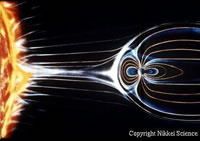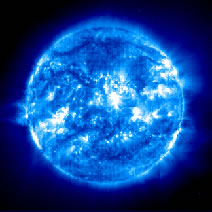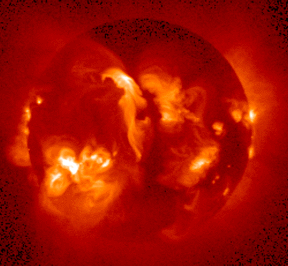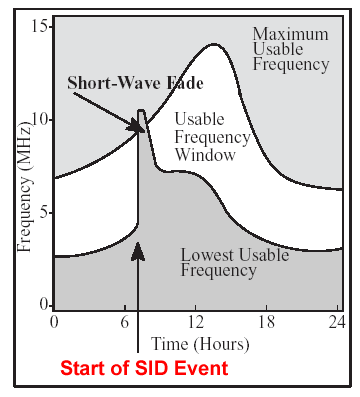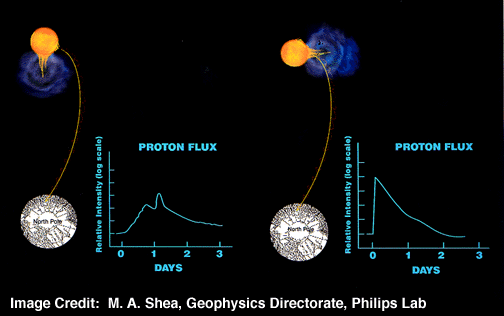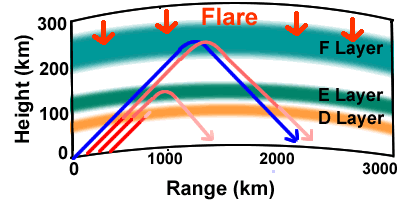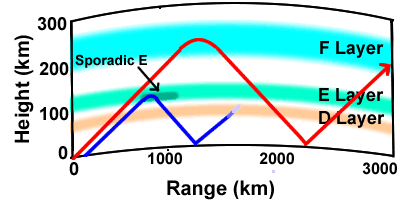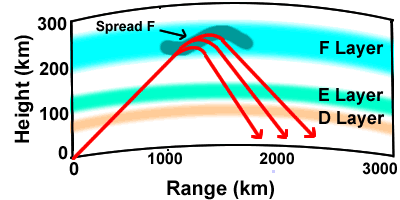Learning Objectives
- Be able to explain what space weather is
- Know what sequence of events that follows a solar flare and how HF transmissions
may be affected.
- Have a working knowledge of the predictability of various space weather
phenomena
- Be able to use the Internet to find information on current and near-term
future space weather events
Introduction to Solar Weather
The diurnal cycle and the solar cycle are processes that occur at predictable
rates i.e. 24 hours and 11 years, respectively. We can also predict how the
solar effects on the ionosphere change with latitude and season. If this was
all there was to predicting HF transmissions, our job would be relatively easy.
Unfortunately there are ionic disturbances that cannot be predicted at all or
can only be predicted a few hours in advance. These disturbances are called
"space weather" and they will be the topic of this page.
Solar Wind
|
The sun continuously emits atomic particles, primarily single protons
and alpha particles. Alpha particles are helium nuclei consisting of two
protons and two neutrons fused together. The protons, alpha particles
and other atomic particles coming from the sun are called the "solar
wind" (Figure 1). The solar wind is charged and therefore it interacts
with the Earth's magnetic field, tending to follow the magnetic lines
down toward the polar regions. Changes in the solar wind can also distort
the magnetic field, therefore the solar wind and Earth's magnetic field
affect each other.
|
|
|
Figure 1. Artist's rendition of solar wind
and its interaction with the earth's magnetic field. Click on image for
large version. Image
courtesy Yohsuke Kamide, created by artist K. Endo, modified by D. Wilkinson.
From
NOAA, Nikkei Science
|
Solar EM Radiation
Photons
The sun emits EM radiation in all wavelengths. Although all EM radiation consists
of photon "particles", for this module we distinguish photons (which
have virtually no mass) from the particles discussed in the previous paragraph.
The overwhelming majority of the sun's EM radiation comes at frequencies that
are much higher than the radio frequencies that are the topic of this module.
We consider this high frequency (and this means really high frequency, not "HF", ) radiation because of the indirect, but important,
influence it has on HF radio transmissions. Photons do not have a charge and
therefore are not affected by the earth's magnetic field and can travel in an
almost straight line from the sun into the ionosphere, unlike the solar wind
particles.
Visible Radiation
Most of the EM radiation (photons) from the sun is in the visible part of the
spectrum. Almost all of this visible radiation passes
through the ionosphere and enters the troposphere. It has a strong effect on
the weather and climate that we a familiar with down here on the surface, but
it does not have much of an effect up in the ionosphere.
Ultraviolet and X-Ray Radiation
The radiation that has the most effect on the ionosphere is at higher frequencies
than visible light. This is in the ultraviolet (UV) and X-ray bands. The wavelengths
of the UV and X-ray photons are so small that they are absorbed by molecules
and atoms in the ionosphere. Similar to solar particles, the sun's output of
these high energy photons is more variable than visible light. Some of this
variability is contained in the 11 year solar cycle. This cycle represents long
term (years) average; on shorter time scales (weeks, hours, minutes) the sun's
ultraviolet, X-ray and solar wind output is highly variable. This is the part
that causes "space weather". Space weather affects the ionosphere
and hence HF radiation. This rest of this page will provide some general information
on space weather and how it affects HF transmissions. Later we will discuss
how to find information on current and near term future space weather.
Solar Flares
| Sometimes enormous eruptions called
solar flares occur on the surface of the sun (Figure 2). Solar flares are
sometimes associated with coronal mass injections (CMEs) which inject mass
from the sun into space. Solar flares and CMEs are most common during solar
maximum periods. When the radiation and particles from these flares reaches
the Earth's ionosphere, an event called a geomagnetic storm occurs resulting
in greatly increased electron densities throughout the ionosphere. The most
important effect is in the D layer where the increased electron density
degrades or completely stops HF transmissions because more of the HF is
absorbed. |
|
Figure 2. This image shows
the solar atmosphere in extreme ultraviolet wavelengths. Note the solar
flares in white and projecting away from the sun's disk around the edges.
Image courtesy NASA. Source.
|
Auroral Zones
These are regions associated with auroras, also known as Northern or Southern
lights. On a typical "quiet" day these are located around 67°
north or south latitude (Figure 3). However because their location is centered
on the geomagnetic poles, not the geometric poles, the location varies throughout
the day. Auroral activity is more intense during solar maximum years and in
particular after flares and/or CMEs have occurred on the sun. The electron density
is increased in the auroral zones. This is important for long range transmissions
that may cross polar regions. Sometimes during geomagnetic storms, the auroral
zones will move toward the equator, affecting transmissions that typically are
not affected by auroras.
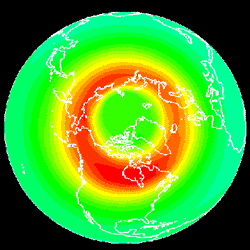 |
Figure 3. Map of average location
of the northern auroral zone (red colors) for one year. Image from Charles
A. Barth, Laboratory
for Atmospheric and Space Physics University of Colorado, Boulder.
Source. |
Effects of Solar Flares
We will now discuss how solar flares and CMEs affect the ionosphere and HF
radio transmissions. The effects can be divided into three categories as summarized
by this table:
| Event |
Arrival Time on Earth after Solar Flare |
Typical Duration Time |
Type of Radiation |
Effects |
| Sudden Ionospheric Disturbances
(SIDs) |
8.3 minutes |
10 - 60 minutes |
Ultraviolet and X-ray photons |
Increase in D-Layer Absorption in all Daytime
Regions |
| Polar Cap Absorption
(PCA) |
15 minutes to several hours |
~1-2 days, sometimes several days |
High energy protons and alpha particles |
Increase in D-Layer Absorption especially in Polar
Regions |
| Ionospheric Storms |
20 - 40 hours |
2 - 5 days |
Low energy protons and electrons |
Increase in D-Layer Absorption, Depression of F2 MUF, auroras, Sporadic
E events
|
Sudden Ionospheric Disturbances (SIDs)
These are also called shortwave fadeouts (SWFs). They are caused by a huge increase in ultraviolet and X-ray photons coming from a solar flare (Figure 4).
This radiation travels down to the D layer where it causes an immediate increase in electron density, resulting in greatly increased HF absorption.
The absorption can be so great that the lowest usable frequency (LUF) becomes higher that the maximum usable frequency (MUF), thus completely cutting off the HF "window" and preventing HF transmission at any frequency (Figure 5.).
SIDs travel at the speed of light and are therefore the first sign that a solar flare is affecting the ionosphere.
Their onset is very rapid, giving the radio user no warning. They affect the entire daylight portion of the earth. |
|
Figure 4 (above).
This is an image of the sun in the X-ray band showing flares that are responsible for SIDs.
Image from the Yohkoh mission of ISAS, Japan. The x-ray telescope was prepared by the Lockheed Palo Alto Research Laboratory, the National Astronomical Observatory of Japan, and the University of Tokyo with the support of NASA and ISAS. From Windows on the Universe.
|
|
|
Figure 5 (left). Diagram showing effect of a sudden ionospheric disturbance (SID) on the usable frequency window which is the unshaded region between the lowest usable frequency (LUF) and the maximum usable frequency (MUF). Normally, both the MUF and LUF increase when the sun rises, thereby keeping a band between them open for HF communications.
But during a strong SID, the LUF will increase to a frequency higher than the MUF, thus closing the usable frequency window, an event called a short wave fadeout. Note the rapid onset of the SID that is typical of these disturbances.
From NOAA. |
Polar Cap Absorption (PCA)
This event is associated with coronal mass ejections (CMEs), often but not
always in conjunction with solar flares. PCA is caused by high energy charged
particles that are accelerated during the CME to velocities much greater
than the solar wind, a sizable fraction of the speed of light. The particles
are trapped by the earth's magnetic field and brought down into the D-layer
in the polar regions (Figure 6). The disturbance then propagates toward
the equator to a latitude of about 65 degrees. They can completely cut-off
transmissions that cross the polar regions by raising the LUF. |
|
|
Figure 6. This image shows how the CME location on the surface of the Sun affects the intensity and arrival time of the high speed solar particles at the Earth.
In the first case, the flare occurred in the center of the Sun on a direct line-of-sight path to the Earth. In the second case, the flare site is on the limb of the Sun, directly connected to the Earth along a curved magnetic field line. The line plot in each case gives the history of the flux (in logarithmic units) as it arrives at Earth. The flare particles, blown out at the limb of the Sun, arrive more rapidly and in greater numbers (flux is almost 10 times higher) than those that began their
journey from the center of the solar disk.
Picture and caption from
Windows on the Universe.
|
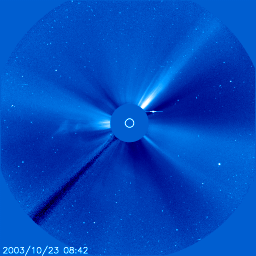 |
Figure 7. Animation of of a large Coronal
Mass Ejection (CME) taken from a telescope on earth. The sun's main disc
is blocked. Source. |
Ionospheric Storms
These are the last major events to occur after a CME.
They are caused by subatomic particles (primarily protons and electrons) that are at a lower energy that the PCA particles. The large increase in particles from a CME creates shock waves in the solar wind (Figure 8). The particles are affected
by the sun's magnetic field and follow a spiral course away from the sun. Once reaching the earth's magnetic field, the particles can cause auroras and a host of problems for HF and other systems. One effect is to decrease the F layer MUF and increase the LUF due to D layer effects (Figure 9).
The result is a narrowed and sometimes nonexistent HF transmission window.
|
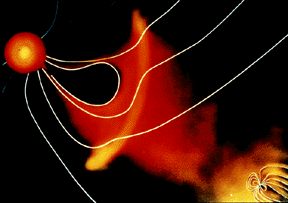 |
| Figure 8. Artist's conception
of an impending collision between a coronal mass ejection and the Earth's
magnetosphere. Image courtesy of the National Aeronautics and Space Administration.
From Windows
on the Universe. |
|
|
Figure 9. Ray diagram showing some effects
of solar flares and CMEs (red raytraces)
compared to a normal, quiet situation (blue raytrace).
Electron densities are increased in all layers, as indicated by the darker colors compared to the other raytrace diagrams.
This can cause increased D layer absorption (as indicated by duller red color for first red ray), unusual E layer refraction (next red ray) or total loss of signal due to enhanced D layer absorption (last red ray).
|
Other Ionospheric Disturbances
Not all disturbances that affect HF transmissions are an immediate consequence
of solar flares or CMEs. There are two general classes of these effects: Transient
Phenomena and Traveling Ionic Disturbances (TIDs).
Transient Phenomena
As the name implies these phenomena occur for short periods of time, typically not more than an hour. They are associated with "clouds"
of free electrons that move horizontally in the ionosphere. There are two main
types, Sporadic E and Spread F.
Sporadic E is an increase in the E layer electron
density that affects a relatively small area.
The effect is to increase the E layer MUF, occasionally making the E layer MUF higher than the F layer MUF.
This means HF transmissions bend down at much lower elevations than is typical (100 km vs. 300 km). Usually this will result in fadeouts and decreased range (Figure 10). However, HF transmissions maybe enhanced at some frequencies and
ranges during Sporadic E events, particularly in typical skip zones.
|
|
Figure 10. Ray diagram of sporadic E
event. HF radio transmissions above the normal E layer MUF (red)
pass through the E layer. During a sporadic E event, signals (blue)
will either be refracted or partially refracted in the E layer, resulting
in decreased long distance transmission, but better reception within
the normal first skip zone.
|
Sporadic E events can last anywhere from a few minutes to several hours. They are unpredictable, but are most common in the mid-latitudes in late spring and early summer from 0800-1200 and 1900-2300 local time. They are more frequent closer to the equator. Sometimes they occur in polar regions during the night when there is an ionospheric storm. There are many theories
for their causes, including converging ionospheric winds, meteors and lightning.
Spread F causes HF radiation to be reflected from different heights within the F layer. Received HF signals are spread in time and space, making frequency resolution difficult, with garbled messages.
It usually occurs at night and is most common around in the equinox months (March and September). Spread F is less common in the mid-latitudes than the equatorial or polar regions. If it does occur in the mid-latitudes it is usually in winter.
In polar regions it can occur during the day as well as at night. It is thought to be caused by large "bubbles" in the ionosphere and is often associated with ionospheric storms that lower the F layer MUF (Figure 11).
|
|
Figure 11. Ray diagram of Spread F event.
The uneven distribution of free electrons in the F layer causes HF to spread out or have other unusual propagation characteristics.
|
Because both sporadic E and spread F are unpredictable, the HF user should keep abreast of the latest space weather reports to avoid problems caused by these events.
Traveling Ionospheric Disturbances (TIDs)
These wave phenomena (sometimes called "acoustic-gravity waves")
travel horizontally through the F region. They are seen as large fronts having a sideways scale of several hundred kilometers. They cause oscillations in the electron density that can last for a few minutes to several hours. This causes
the height of refraction and the MUF to undergo rapid variations. TID effects on HF communications are usually not too serious.
The largest TIDs start in the aural zones and propagate toward the equator. Thunderstorms can cause smaller TID fronts that travel about 200 kilometers
before dissipating.
Getting Information on Current and Future Solar Weather
There are several internet locations that provide information about space weather.
Here are some web sites that are useful for this purpose:
www.sel.noaa.gov/ The Space Weather Prediction Center
This site is operated by NOAA and is a national and world warning center for disturbances that can affect people and equipment working in the space environment. Includes "Space Weather Now" at http://www.swpc.noaa.gov/SWN/index.html
http://www.ips.gov.au/ Australian Space Weather Site
This is a very useful public site that provides information on space weather and HF effects in an easy-to-use graphical format.
http://www.spaceweather.com/ SpaceWeather.com
A "newspaper" style unofficial site created by Dr. Tony Phillips
http://space.rice.edu/ISTP/dials.html
Rice University
Space weather conditions using a simple "stop light" scale.
http://sohowww.nascom.nasa.gov/spaceweather/
NASA and ESA's SOHO Satellite
Plots of current space weather parameters from the SOHO satellite.
www.schriever.af.mil/ Schriever Air
Force Base
This was the official US military center for space weather, but it does not appear to have any available information on current space weather conditions at this time.
Summary of Space Weather
Space weather refers to disturbances that affect the ionosphere and HF communications on an irregular basis. Events on the surface of the sun such as solar flares and CMEs often cause solar weather events, but solar weather can also be affected
by events that originate with the earth's atmosphere. Space weather is hard to predict, therefore anyone involved in missions that use HF communications or related operations should check one or more of the internet links above before commencing
operations.
Study Questions
1. What is space weather?
2. Why is the solar wind affected by earth's magnetic field?
3. Are ultraviolet and X-rays part of the solar wind?
4. When are the auroral zones most active?
5. List in order of appearance the three events affecting HF that occur after
a solar flare or coronal masss ejection (CME)?
6. What causes solar ionospheric disturbances (SIDs)?
7. What effects does polar cap absorption have on HF propagation?
8. What are the effects of sporadic E events on HF propagation?
9. Are sporadic E and spread F events easy to predict?
10. Is it possible to get real time information on space weather? Where?


